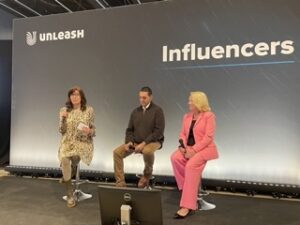Who's that Girl?
The Future of HR: Agile Workplaces
Originally posted: December 10, 2009 on TrishMcFarlane.com
The Senior HR Executive Conference.
Just hearing those words for most of my career made me picture some off-limits, highly secretive conference where you have to know the secret knock or secret handshake to be allowed entry. That and a wealth of HR experience under your belt. It was the one conference I did not know if I would ever make it to during my HR career. Well, my perception could not have been farther from reality.
I was asked to participate in this year’s conference in order to give feedback on how The Conference Board can bring more aspects of social media for HR into the future events and how the conference can expand it’s reach to Gen X and Gen Y. I’m excited to tell you that as an organization, The Conference Board is fully embracing social media and the up-and-coming generations. Now, it’s up to all of us to reach back as they are reaching out to us.
As an attendee at the Senior HR Executive Conference, participants are in store for more learning than most other conferences out there offer. Each informative session is presented by a top global HR executive, so it is challenging to determine where to begin in sharing what I learned. I have decided to begin at the end of day one, the Keynote session. This session was presented by Fiona C. Laird of Unilever. Fiona is the Senior Vice President of Human Resources and Communications for the Americas.
So, picture it. You are in a ballroom of the Intercontinental Hotel in New York City. You are seated with 100 of the top HR executives from around the world. Then, Fiona is announced. Two things immediately strike you; first, she is incredibly polished and professional. Her presence fills the room. Second, as she begins speaking, you realize that her storytelling style will engage this challenging crowd in ways that more speakers dream of.
Fiona’s keynote, “Enabling the Future Workforce” accomplished several things. She told the story of Unilever, a world-class company that provides over 400 brands of personal care, home, and food globally. Brands you use such as Hellmann’s, Lipton, Dove, Vaseline, and Surf. What is truly different and unique about Unilever is they are so forward thinking when it comes to their people. Fiona told us their story of bringing an agile workplace into play at Unilever.
What is an agile workplace? It is something that goes several steps beyond just the talk of work flexibility. The agile workplace focuses on three areas; practices, facilities, and technology.
- Practices– In order to implement an agile workforce, you will need to offer agile and flexible work experiences to all or as many employees as possible. This means that performance is measured on the output of work, not on the hours you work or where you work them. At Unilever, they were able to offer this flexibility to all employees. It was a huge change that forced managers to have trust that employees would get their work done. It also was a process where managers had to have ongoing discussions with employees to ensure that it was working.
- Facilities– Much like your home is divided into different rooms with different functions (kitchen for cooking, bedroom for sleeping, etc.) an agile workplace throws out the use of office space in a traditional office/cubicle layout. In an agile workspace, there are areas to focus and work independently, then employees can move to areas where they can connect and collaborate with other employees. There are also areas for vitality like break rooms, kitchens, and cafes. Unilever was able to reduce their real estate footprint when they moved to this model. They are using approximately 40% less space. The key is that ALL employees, from the non-exempt to the executives, are expected to use the same work areas. It is working for Unilever.
- Technology– You must invest in technologies in order for an agile workplace to work. First, virtual collaboration technologies such as telepresence meetings can help reduce the cost of global travel for employees. Second, advanced mobility technologies will need to be used to facilitate employees having ease of working from other locations.
When an agile workplace is in place, there will be a cost savings on the real estate footprint. Tech costs increase initially, however travel costs decrease. It really is a trade off.
So, do you see this type of work environment gaining popularity in the future? How do you think this would impact HR and providing service to employees?
Author
Categories
Tags
Share
Related Posts
How we can help
Led by Trish Steed and Steve Boese, H3 HR Advisors harnesses over 40 years of experience to delivery HCM insights and guidance to global organizations.
H3 HR Advisory services
By leveraging technology, analytics, and our deep industry knowledge we can help you to reposition your workforce and ensure that you have the right people with the right capabilities in the right roles to positively impact the growth of your business.
HR Happy Hour Podcast Network
Created in 2009, The HR Happy Hour Show is hosted by Steve Boese and Trish Steed and is the longest continuously running internet radio show and podcast on Human Resources, HR Technology, Talent Practices, Workplace and Leadership topics.
H3 HR Speaking Services
We work closely with every client to customize your content - keynotes, webinars, research, infographics, and buyer’s guides - to inspire, educate and inform the audience enabling you to reset and realign your organization for a talent-led breakthrough.
Get in touch
Talk to us today and find out how we can help you and your organization leverage HCM technology to attract, onboard, retain and manage top talent.


